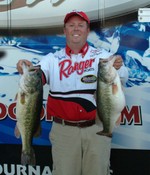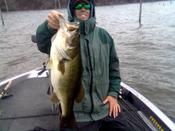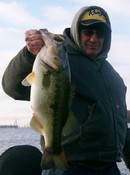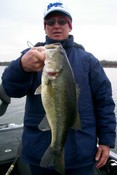 2008 is off to a good start for my customers and me. I spent the first part of this month fishing the FLW Stren Series event on Falcon and caught them well, sitting in 5th place on day 2 before struggling on day 3 and finishing in 19th place. Now I’m back to fishing Lake Fork on a daily basis and although the weather has been chilly, the bass don’t seem to mind. We had 11 to 17 fish in the boat on most days this past week, although we only boated 7 fish on one slow day. Early prespawn females are starting to show up in their usual locations, and we caught a lot of fish with big bellies, including a 9 lb 3 oz beauty and a good number of chunks in the 5 to 7 lb category, with only 1 or 2 dinks each day. Regardless of the weather over then next two months, staging fish will continue to show up in the shallows in preparation for the spawn, making this the best time of the year to catch a true giant on Fork. Until bass start to spawn in March, my fishing patterns will remain basically the same. That’s good news for those of you who find fish now, as you’ll be able to hammer them for the next two months.
2008 is off to a good start for my customers and me. I spent the first part of this month fishing the FLW Stren Series event on Falcon and caught them well, sitting in 5th place on day 2 before struggling on day 3 and finishing in 19th place. Now I’m back to fishing Lake Fork on a daily basis and although the weather has been chilly, the bass don’t seem to mind. We had 11 to 17 fish in the boat on most days this past week, although we only boated 7 fish on one slow day. Early prespawn females are starting to show up in their usual locations, and we caught a lot of fish with big bellies, including a 9 lb 3 oz beauty and a good number of chunks in the 5 to 7 lb category, with only 1 or 2 dinks each day. Regardless of the weather over then next two months, staging fish will continue to show up in the shallows in preparation for the spawn, making this the best time of the year to catch a true giant on Fork. Until bass start to spawn in March, my fishing patterns will remain basically the same. That’s good news for those of you who find fish now, as you’ll be able to hammer them for the next two months.
Lake Conditions: Fork is holding steady around about 4” below full pool, currently reading 402.66’. The lake is full of aquatic vegetation, with a deep weedline anywhere from 8’ to about 15’. The main lake is clear, while the creeks are ranging from clear to stained. Water temps were reading from 47 to 52 degrees on Monday, normal wintertime water temps for Fork.
 Location Pattern: From now through much of March, I concentrate on prespawn and staging fish on points and along edges of flats or creek channels. Areas with submerged vegetation (primarily hydrilla, milfoil or coontail) for cover will typically have the most active fish. While about any grassy area will hold a few fish, start your search in areas that have lots of spawning fish in late February through March. It stands to reason that the coves that hold the most spawning fish in early spring will have the most prespawn fish in the winter. Main lake grass beds near the mouths of these coves are holding a lot of fish now, as are main and secondary points inside the coves, provided there is deep water nearby. During warming trends, follow bass back into the creeks and check the edges of grass flats and creek channels.
Location Pattern: From now through much of March, I concentrate on prespawn and staging fish on points and along edges of flats or creek channels. Areas with submerged vegetation (primarily hydrilla, milfoil or coontail) for cover will typically have the most active fish. While about any grassy area will hold a few fish, start your search in areas that have lots of spawning fish in late February through March. It stands to reason that the coves that hold the most spawning fish in early spring will have the most prespawn fish in the winter. Main lake grass beds near the mouths of these coves are holding a lot of fish now, as are main and secondary points inside the coves, provided there is deep water nearby. During warming trends, follow bass back into the creeks and check the edges of grass flats and creek channels.
Keep in mind, too, that the absolute water temperature is not nearly as important now as the recent water temperature trend. For instance, water temps that are showing 52 degrees can result in slow fishing if the temps were 58 a couple days ago. In contrast, fishing can be great if the temps warm up to 50 while they were 44 a few days before. In general, look for bass on the flats and farther back in creeks during warming trends; conversely, drop back to points and main lake grassbeds after cold fronts. Finally, the day of and the day after cold fronts can be absolutely miserable to fish, but these frontal days after a long warming trend are usually the most productive times to fish.
For deep structure enthusiasts, points, roadbeds, humps, flats and ledges in 18’ to 45’ will produce some big fish during the winter months as well. Use your electronics to find the schools of bass and baitfish and work them over with spoons and dropshots. I’m primarily concentrating on the shallow bass, so my presentation pattern will focus on that.
 Presentation Pattern: My wintertime arsenal is pretty simple for fishing along grasslines and creek channels. First and foremost are red lipless crankbaits in ½ or ¾ oz. Stick with the ½ for grass that is near the surface and go with the ¾ for grass that is deeper. Buzzing these over the top of the grass on a quick retrieve is working best now, but after cold fronts, letting the trap fall and ripping these out of the grass will trigger most of the bites. ¼ to ½ oz spinnerbaits with double willow blades in white, red, or chartreuse and white will produce some really large bass in the same areas that the lipless cranks work, especially on windy and cloudy days. For a true giant, try swimming the new 5.5” Live Magic Shad in the same areas you’d throw a spinnerbait. Rig it on the new Lake Fork Trophy Lures 7/0 wide gap hook and swim it slowly back to the boat with a few pauses. When the water looks like a toilet just flushed, it’s time to set the hook!! When the bite slows or the conditions are sunny and calm, I’ll switch to a suspending jerkbait or pitch a jig and a Texas rig. Jerkbaits in gold or clown patterns are my primary colors. Work these with long pauses over the grass and along the edges. For jigs, I go with ½ oz black and blue jigs with a Fork Craw trailer in the blue bruiser color. For the Texas rig, I’ll pitch a Lake Fork Flipper in black neon or blue bruiser with a ¼ to 3/8 oz bullet weight. Work your jig or Texas rig very slowly along creek channels or through deep grass for your best shot at a lunker.
Presentation Pattern: My wintertime arsenal is pretty simple for fishing along grasslines and creek channels. First and foremost are red lipless crankbaits in ½ or ¾ oz. Stick with the ½ for grass that is near the surface and go with the ¾ for grass that is deeper. Buzzing these over the top of the grass on a quick retrieve is working best now, but after cold fronts, letting the trap fall and ripping these out of the grass will trigger most of the bites. ¼ to ½ oz spinnerbaits with double willow blades in white, red, or chartreuse and white will produce some really large bass in the same areas that the lipless cranks work, especially on windy and cloudy days. For a true giant, try swimming the new 5.5” Live Magic Shad in the same areas you’d throw a spinnerbait. Rig it on the new Lake Fork Trophy Lures 7/0 wide gap hook and swim it slowly back to the boat with a few pauses. When the water looks like a toilet just flushed, it’s time to set the hook!! When the bite slows or the conditions are sunny and calm, I’ll switch to a suspending jerkbait or pitch a jig and a Texas rig. Jerkbaits in gold or clown patterns are my primary colors. Work these with long pauses over the grass and along the edges. For jigs, I go with ½ oz black and blue jigs with a Fork Craw trailer in the blue bruiser color. For the Texas rig, I’ll pitch a Lake Fork Flipper in black neon or blue bruiser with a ¼ to 3/8 oz bullet weight. Work your jig or Texas rig very slowly along creek channels or through deep grass for your best shot at a lunker.
 Cover lots of water until you get bit. Once you catch one, work the area over thoroughly with multiple passes, employing several different baits. Fish tend to stack up in key staging areas during the winter and these spots will replenish themselves with more fish during the prespawn as more and more big bass move shallow. Find some good staging spots and you’ll have a milk run of honey holes now through March.
Cover lots of water until you get bit. Once you catch one, work the area over thoroughly with multiple passes, employing several different baits. Fish tend to stack up in key staging areas during the winter and these spots will replenish themselves with more fish during the prespawn as more and more big bass move shallow. Find some good staging spots and you’ll have a milk run of honey holes now through March.
Here’s hoping you catch the lunker of your dreams. If I can be of assistance, please contact me at 214-683-9572 (days) or 972-635-6027 (evenings) or e-mail me through http://www.LakeForkGuideTrips.com , where your satisfaction is guaranteed.
Good Fishing,
Tom
Here are the full size pics.
Steve and Stuart took a break from winter in IL and caught a number of good bass:

I caught this short and fat 9 lb 3 oz beauty while fishing with relatives:

A couple of bass from my 28 lb 6 oz limit on day 1 of the Stren Series tourney:

Nice report and congrats on the decent tournament finish. I’m kind of jealous of you southern guys. Then yesterday my buddy told me he is leaving for Falcon next friday. I’m considering heading down that way the middle of next month.
Jason
Your killing these boys Tom!! Any jab at a bass fisherman is a good jab.
Any jab at a bass fisherman is a good jab. 
Great fish!
Look at that belly in the last pic. What a tank!
What a tank!  Great report Tom.
Great report Tom.
great report and beautiful bass…just like I would catch
Eric
Wow! Looks like the one on the right slurped up a down rigger weight
Tom what do beleive that belly is full of?
I’d guess eggs Matt. The spawn shouldn’t be too far away down there.
LOL, thanks guys. That fish was full of eggs and fish. It had a big tail sticking out of its gullet, probably a bluegill, tilapia or a smaller bass. Apparently that pregnant lady was having cravings for fish (and plastic too).
I get lots of questions on Falcon vs. Amistad vs. Fork. Falcon’s a great lake, I think it is way better than Amistad (Amistad’s getting ton of pressure these days and still putting out good sacks, but not the whack fest it was down there a few years ago). Falcon’s 8 hours south of me, so they’re ready to spawn there right now, we actually saw a few on beds. The numbers of fish from 3 to 7 lbs are staggering there. The lake is in the absolute middle of nowhere and the fish just don’t get any pressure (that’ll be changing this year). Some big fish, too. If you’re looking for a lot of 3 to 7s, that lake would be hard to beat. For 8+ plus and especially 13s or over, Fork’s still the king. Fork has 35 of the top 50 bass of all time for TX. For springtime ShareLunker enteries (fish donated to the state over 13 lbs), Fork leads the state with 236 entries. Alan Henry is 2nd with 26 entries. Falcon and Amistad both have 7 entries each (both lakes had 1 entry each in the program last year, Fork had a down year with only 8 entries). If they every waived the slot on Fork for a regular 5 fish tourney for the pros in the spring, the weights here would be staggering.
We’re very fortunate to have dozens of lakes that most any other state in the country would love to have (Rayburn, Fork, Toledo Bend, Choke Canyon, Amistad, Falcon, etc). Even our chump lakes take 5 fish for 20 lbs to win in the spring time. Best of all, the state manages our lakes for quantitiesof quality bass, not for weedless ski ponds. It’s as close to bass paradise as I’ve found!
Tom,
Great report and Great Pics…
I sure may have to think about hitting Fork one of these days…
Awesome..
Jack..
Real nice report! Those are some nice fish for sure. Keep up the good work.
WOW is all I can Say Congrats
Congrats 